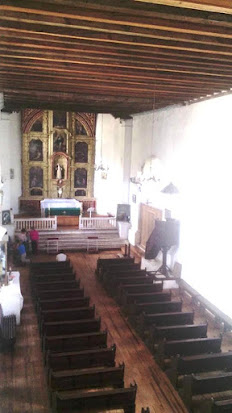Saturday, May 29, 2021
Chihuahua. San Nicolás de La Hoya
It was once a building of some substance with massive nave walls enclosing a narrow nave. The cracked rectangular front incorporates a large bell tower.
Tuesday, May 25, 2021
Chihuahua. Santa Ana de la Joya
The third in our survey of Chihuahua churches with painted ceilings is the modest church of Santa Ana de la Joya, near Satevó.
Behind the modest church front, the entire nave is roofed by a wooden beamed ceiling, mostly of more recent construction.
The exception is the older under choir, divided into sections with painted beams and on the intervening planks floral motifs and ribbon like scrolls.
text © 2021 Richard D. Perry
color images © Niccolo Brooker by gracious permission
Thursday, May 20, 2021
Chihuahua. Cusihuiriachi
For the next in our series on the churches of Chihuahua with painted ceilings, we go to Santa Rosa de Lima Cusihuiriachi.
In 1687, a major silver strike was found at Cusihuiriachi. Quickly the Real de Santa Rosa de Cusihuiriachi became one of the most important mines in the northwest of the state of Chihuahua, the locale attracting many Spaniards and Creoles.
The highlight of the church interor is its gilded late baroque altarpiece which frames 10 paintings illustrating the life of Santa Rosa de Lima some signed by the noted Basque artist José de Alcibar.
Saturday, May 15, 2021
Chihuahua. Santa Maria de Cuevas.
We start with posts on Chihuahua, focusing on a group of churches with painted wooden ceilings, a feature rare in Mexico outside western Michoacán.
First we consider the church of Santa Maria de Cuevas, a late Jesuit foundation in the Tarahumara region of Mexico.
whose signature feature is its painted beamed wooden ceilings, along the entire nave and over the underchoir as well as murals above the sanctuary arch and baptistry.
The nave walls were also painted at one time, but are now largely whitewashed.
The Nave
The eight painted divisions spanning the nave between the beams employ centrally placed Marian symbols set in diamond shaped frames or floating amid repetitive floral motifs; these include the sun, moon, star, a mirror, a fountain, a cypress tree, a lily and a rose.
On either side of the sanctuary arch angels uphold banners with Latin inscriptions that together, read “ all future generations will call me blessed” .
The Baptistry arch
Here two archangels gesture to a Christic monogram with an inscription referring to a Jesuit missionary.
The Choir.
Monday, May 10, 2021
Puebla. San Diego Huejotzingo:The Mystic Vintage
Wednesday, May 5, 2021
Puebla. Tlacomulco Ixtacamaxtitlan
We cannot leave Ixtacamaxtitlan without a mention of its most unusual monument, the chapel of Tlacomulco, perched on a high local peak.
Founded in the 16th century atop a prehispanic hilltop shrine, and also dedicated to St. Francis, the little church has been altered over the centuries, with the addition of domes and a new facade.






























